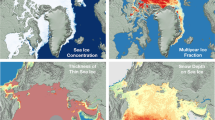Abstract
Snow cover is an important variable for climatic and hydrologic models due to its effects on surface albedo, energy, and moisture budgets. Passive microwave sensors can be used to monitor temporal and spatial variations in large-scale snow cover parameters, avoiding problems of cloud cover and polar nights.
In the present study, brightness temperature values were estimated (using calibration curves) for moist snow on natural and blackbody/metal surface. TB response on snow depth, density, SWE and angular variation from nadir were measured and found that TB decreases with increase of snow depth and with increase of angle from nadir. Empirical relations were used to estimate emissivity, dielectric constant and dielectric loss factor. It was observed that emissivity decreases with the increase of dielectric constant. The dielectric constant and dielectric loss factor both increases with the increase of density.
Experiments were performed during winter of year 2005 at Dhundi and Solang (H.P.), India, using ground based passive microwave radiometer having 6.9 and 18.7 GHz antenna frequencies at dual polarization.
Similar content being viewed by others
References
Chang, A.T.C., Gloersen, P., Schmugge, T., Wilheit, T.T. and Zwally, H.J. (1976). Microwave emission from snow and glacier ice.Journal of Glaciology,16(74): 23–39.
Flore, J.V. and Grody, N.C. (1992). Classification of snow cover and precipitation using SSM/I measurements.International Journal of Remote Sensing,13(17): 3349–3361.
Foster, J.L., Hall, D.K. and Chang, A.T.C. (1984). An Overview of Passive Microwave Research and Results.Reviews of Geophysics and Space Physics,22(2): 195–208.
Linlor, W.I. (1980). Permittivity and attenuation of wet snow between 4 and 12 GHz.Journal of Applied Physics,51(5): 2811–2816.
Singh, K.K., Mishra, YD. and Sharma, J.K. (2005). Spatial and Temporal Variation of Snow Characteristics in Himalayas Using Passive Microwave Remote Sensing (AMSRE). 5th Indian conference on Microwave, antenna, propagation and remote sensing, held at International centre for radio science, Jodhpur from Dec. 20–22, 2005.
Srivastav, S.K. and Singh, R.P. (1991). Microwave radiometry of snow-covered terrains.International Journal of Remote Sensing,12(10): 2117–2131.
Tiuri, M.E. (1982). Theoretical and experimental studies of microwave emission signatures of snow.I.E.E.E. Transactions on Geoscience and Remote Sensing,20(1): 51–57.
Ulaby, F.T. and Stiles, W.H. (1980). The active and Passive Microwave Response to Snow Parameters.Journal of Geophysical Research,85(C2): 1045–1049.
Ulaby, F.T., Moore, R.K. and Fung, A.K. (1986). Microwave remote sensing: From Theory to Applications, Arctech House, Reading, MA, Vol. 3, pp. 2059–2081.
Author information
Authors and Affiliations
Corresponding author
About this article
Cite this article
Singh, K.K., Mishra, V.D. & Garg, R.K. Microwave response of seasonal snow-cover measured by using a ground-based radiometer at 6.93 and 18.7 ghz frequencies and at dual polarization. J Indian Soc Remote Sens 35, 243–251 (2007). https://doi.org/10.1007/BF03013492
Received:
Revised:
Issue Date:
DOI: https://doi.org/10.1007/BF03013492




